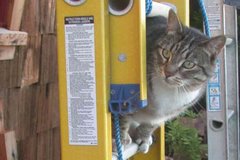<H2>2016.11.10</H2>
<H2>First Core Site! </H2>
We just collected our first core in the region east of the Cook Strait (to the west of the core sites that I highlighted in the previous blog post). The core is now tied to a vertical post aboard the ship. We need to let these cores sit for 12 hours before that they can be X-Rayed. So, after breakfast in the morning, we will start working on these first cores. The core tip had almost pure clay on the tip, with no forams. The core liner is a translucent plastic and it was evident that there were gaps in the sediment (we will collect a second core here to attempt to get a more full sediment core). The piston core configuration (I will post photos later) includes a weight stand with a mass of about 730 kg. This is a small mass compared to piston cores that I have collected on other ships.
Dr. Jaime Howarth and I will be describing the sediments in the cores. Dr. Jenni Hopkins will be focusing on describing the tephras that we expect to find in the cores that we collect. Dr. Hopkins is a post doc on this cruise (she works on other data too, but will be incorporating results from this cruise into her research). There are two students who will be assisting us in these descriptions, who will be working on MS projects possibly related to the data we collect on this cruise. Drs. Howarth, Hopkins, and myself worked with Dr. Alan Orpin (NIWA) to develop the workflow for the core processing. I will discuss this more later. Suffice it to say, we have a draft plan and will update it as we find opportunities for improvement. We like to stay flexible in this regard.
Later Dr. Howarth and I prepared the lithologic description core sheets. These are paper sheets that have a template in which we write and draw our observations about the sediment cores. I include a low resolution version of this core lithologic log in this post. We incorporated some core log sheet content that I have used aboard other turbidite coring cruises, most recently the cruise in the Lesser Antilles this past summer. We modified these core log sheets to suit the needs of this cruise. We took into mind the interests of the chief scientist (Dr. Phil Barnes) and based our decisions upon the experience we have each had doing this type of work. It is important to spend considerable time designing this form so that it is (1) comprehensive, (2) easy to use (i.e. fill out), and (3) easy to use (i.e. read and interpret later). These core logs will be used for years, if not decades, from
now by people interested in our results. We will scan each core log and eventually prepare digital figure files with these data, along with all other core data.
OK, time to hit the sack. We have lots of work to do tomorrow. The first few cores are often the more time consuming cores to describe and process because we will be test running our workflow for the first time. But, once we have processed and described several cores, we will have a rhythm and these descriptions will be done in a more timely manner.
Thursday, November 10, 2016
Subscribe to:
Post Comments (Atom)



No comments:
Post a Comment